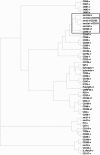A novel interface consisting of homologous immunoglobulin superfamily members with multiple functions
- PMID: 20081873
- PMCID: PMC4003259
- DOI: 10.1038/cmi.2009.108
A novel interface consisting of homologous immunoglobulin superfamily members with multiple functions
Abstract
Immunoglobulin superfamily (IgSF) members account for a large proportion of cell adhesion molecules that perform important immunological functions, including recognizing a variety of counterpart molecules on the cell surface or extracellular matrix. The findings that CD155/poliovirus receptor (PVR) and CD112/nectin-2 are the ligands for CD226/platelet and T-cell activation antigen 1 (PTA1)/DNAX accessory molecular-1 (DNAM-1), CD96/tactile and Washington University cell adhesion molecule (WUCAM) and that CD226 is physically and functionally associated with lymphocyte function-associated antigen-1 (LFA-1) on natural killer (NK) and activated T cells have largely expanded our knowledge about the functions of CD226, CD96, WUCAM and LFA-1 and their respective ligands, CD155, CD112, intercellular adhesion molecule (ICAM)-1 and junctional adhesion molecule (JAM)-1. The interactions of these receptors and their ligands are involved in many key functions of immune cells including naive T cells, cytotoxic T cells, NK cells, NK T cells, monocytes, dendritic cells, mast cells and platelets/megakaryocytes.
Figures





Similar articles
-
Functional characterization of DNAM-1 (CD226) interaction with its ligands PVR (CD155) and nectin-2 (PRR-2/CD112).Int Immunol. 2004 Apr;16(4):533-8. doi: 10.1093/intimm/dxh059. Int Immunol. 2004. PMID: 15039383
-
DNAM-1 control of natural killer cells functions through nectin and nectin-like proteins.Immunol Cell Biol. 2014 Mar;92(3):237-44. doi: 10.1038/icb.2013.95. Epub 2013 Dec 17. Immunol Cell Biol. 2014. PMID: 24343663 Review.
-
Poliovirus receptor (PVR)-like protein cosignaling network: new opportunities for cancer immunotherapy.J Exp Clin Cancer Res. 2021 Aug 25;40(1):267. doi: 10.1186/s13046-021-02068-5. J Exp Clin Cancer Res. 2021. PMID: 34433460 Free PMC article. Review.
-
Identification of PVR (CD155) and Nectin-2 (CD112) as cell surface ligands for the human DNAM-1 (CD226) activating molecule.J Exp Med. 2003 Aug 18;198(4):557-67. doi: 10.1084/jem.20030788. Epub 2003 Aug 11. J Exp Med. 2003. PMID: 12913096 Free PMC article.
-
Interaction between nectin-1 and the human natural killer cell receptor CD96.PLoS One. 2019 Feb 13;14(2):e0212443. doi: 10.1371/journal.pone.0212443. eCollection 2019. PLoS One. 2019. PMID: 30759143 Free PMC article.
Cited by
-
RNA-Seq analysis of ileocecal valve and peripheral blood from Holstein cattle infected with Mycobacterium avium subsp. paratuberculosis revealed dysregulation of the CXCL8/IL8 signaling pathway.Sci Rep. 2019 Oct 16;9(1):14845. doi: 10.1038/s41598-019-51328-0. Sci Rep. 2019. PMID: 31619718 Free PMC article.
-
Human cytomegalovirus glycoprotein UL141 targets the TRAIL death receptors to thwart host innate antiviral defenses.Cell Host Microbe. 2013 Mar 13;13(3):324-35. doi: 10.1016/j.chom.2013.02.003. Cell Host Microbe. 2013. PMID: 23498957 Free PMC article.
-
Role of CD155/TIGIT in Digestive Cancers: Promising Cancer Target for Immunotherapy.Front Oncol. 2022 Mar 30;12:844260. doi: 10.3389/fonc.2022.844260. eCollection 2022. Front Oncol. 2022. PMID: 35433470 Free PMC article. Review.
-
TIGIT as a Promising Therapeutic Target in Autoimmune Diseases.Front Immunol. 2022 Jun 3;13:911919. doi: 10.3389/fimmu.2022.911919. eCollection 2022. Front Immunol. 2022. PMID: 35720417 Free PMC article. Review.
-
Mechanisms of Foreign Body Giant Cell Formation in Response to Implantable Biomaterials.Polymers (Basel). 2023 Mar 6;15(5):1313. doi: 10.3390/polym15051313. Polymers (Basel). 2023. PMID: 36904554 Free PMC article. Review.
References
-
- Williams AF, Barclay AN. The immunoglobulin superfamily – domains for cell surface recognition. Annu Rev Immunol. 1988;6:381–405. - PubMed
-
- Available from: http://www.hlda8.org
-
- Reymond N, Fabre S, Lecocq E, Adelaide J, Dubreuil P, Lopez M. Nectin4/PRR4, a new afadin-associated member of the nectin family that trans-interacts with nectin1/PRR1 through V domain interaction. J Biol Chem. 2001;276:43205–43215. - PubMed
-
- Mueller S, Wimmer E. Recruitment of nectin-3 to cell–cell junctions through trans-heterophilic interaction with CD155, a vitronectin and poliovirus receptor that localizes to alphavbeta3 integrin-containing membrane microdomains. J Biol Chem. 2003;278:31251–31260. - PubMed
Publication types
MeSH terms
Substances
LinkOut - more resources
Full Text Sources
Other Literature Sources
Research Materials
Miscellaneous

